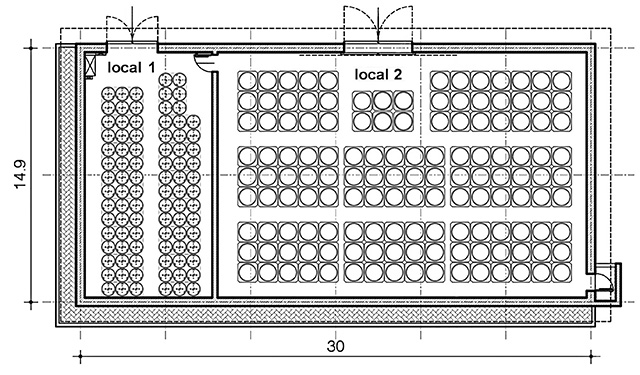Corrosion is a relentless and unforgiving enemy of metal, and the battle against it simply cannot be lost when steel drums full of nuclear waste are involved. Such is the situation in Italy, where domestic nuclear power production has been halted, yet the need is ongoing to safely store low-level radioactive waste produced as a byproduct of power generation, research, medical, and industrial activities.
Nuclear Waste Storage Requires Accurate Humidity Control
Sogin S.p.A. (Società Gestione Impianti Nucleari) (Rome, Italy) is the Italian state-owned company responsible for decommissioning Italy's nuclear sites and managing radioactive waste. One of its projects is the ongoing renovation of a building at a former nuclear power plant located in the center of Italy. The goal is to meet Italian and international requirements for temporary storage of low-level radioactive waste until the waste can be delivered to a permanent national repository.
The temporary facility is single-floor rectangular space, ~30 by 15 m, that is divided into two rooms. The waste is stored in steel drums encased in concrete for radiological reasons. The drums have an external diameter of 0.8 m, while the overpack is one meter in diameter. Relative humidity (RH) of 65% or lower must be maintained to prevent corrosion.
“The need to control air humidity is due to the non-stainless steel drums that are used,” says Gianluca Barbella, a Sogin structural engineer and team leader for the project. “The concrete overpacks mean the drums aren’t inspectable without first extracting them, which makes it difficult to constantly monitor the corrosion process. Also, the site is exposed to high levels of relative humidity. Therefore, humidity control is critical.”
However, the cost of operating a heating, ventilating, and air-conditioning (HVAC) system to maintain optimum conditions over the anticipated 25-year life of the facility is substantial. In addition, because the facility can’t be expanded, an HVAC system’s space requirements would result in less space available for waste storage. Moreover, HVAC system downtime is inevitable because of both equipment malfunctions and scheduled maintenance.
A potential alternative is to use industrial isothermal dehumidifiers, which are relatively small, mobile, require less maintenance, and have substantially lower operating costs. These units are based on the reverse Carnot thermal cycle: A fan draws air into the unit, where it passes over an evaporator and is cooled. Excess moisture from the air condenses into drops of water that fall into a tank. The air then passes through a condenser where it is warmed by several degrees and recycled into the environment as drier, warmer air.
The Sogin project relied on numerical simulation to study the impact of various sizes and configurations of two different industrial isothermal dehumidifiers. The simulations helped Sogin design a simple, energy-efficient dehumidification system to prevent corrosion in drums of radioactive waste. The analyses were carried out by Piergianni Geraldini from Sogin’s mechanical design department. The goals were to identify equipment requirements and to determine optimum placement of the units in the rooms (see Figure 1).

Simulations Determine Optimum Layout
First, the turbulent air flow in the room was studied by performing stationary fluid-flow studies based on a single-phase incompressible k-epsilon turbulence model. The model’s purpose was to reproduce the air velocity field in the storage area while the dehumidifiers were in use. The results from these studies were then used in time-dependent, fully-coupled simulations to study heat and moisture transfer within the room’s atmosphere (Figure 2). All simulations were conducted using COMSOL (Burlington, Massachusetts) Multiphysics†, a general-purpose software platform based on advanced numerical methods for modeling and simulating physics-based problems, and its heat transfer module. The overall results were used to develop an optimum layout for the dehumidifiers and helped engineers design a dehumidification system that would minimize stagnant air, enable maximum operating efficiency, and optimize RH.

“Without such a refined simulation tool, we would have had to model the dehumidification process using simplified approximations coupled with dehumidifier performance curves supplied by the units’ manufacturers,” says Piergianni. “But the simulations showed us a way to solve 3D [three-dimensional] heat and moisture transfer problems.”
“The COMSOL simulations helped us to design a layout based on the use of two dehumidifiers that provide the same dehumidification capacity as other configurations, but they required four units,” Barbella states. “The system we designed will limit stagnant air pockets, enable the units to operate at peak efficiency, and help us reduce the risk of drum corrosion once the facility is finalized and commissioned.”
†Trade name.
Contact: Shari Worthington, COMSOL—e-mail: sharilee@telesian.com.